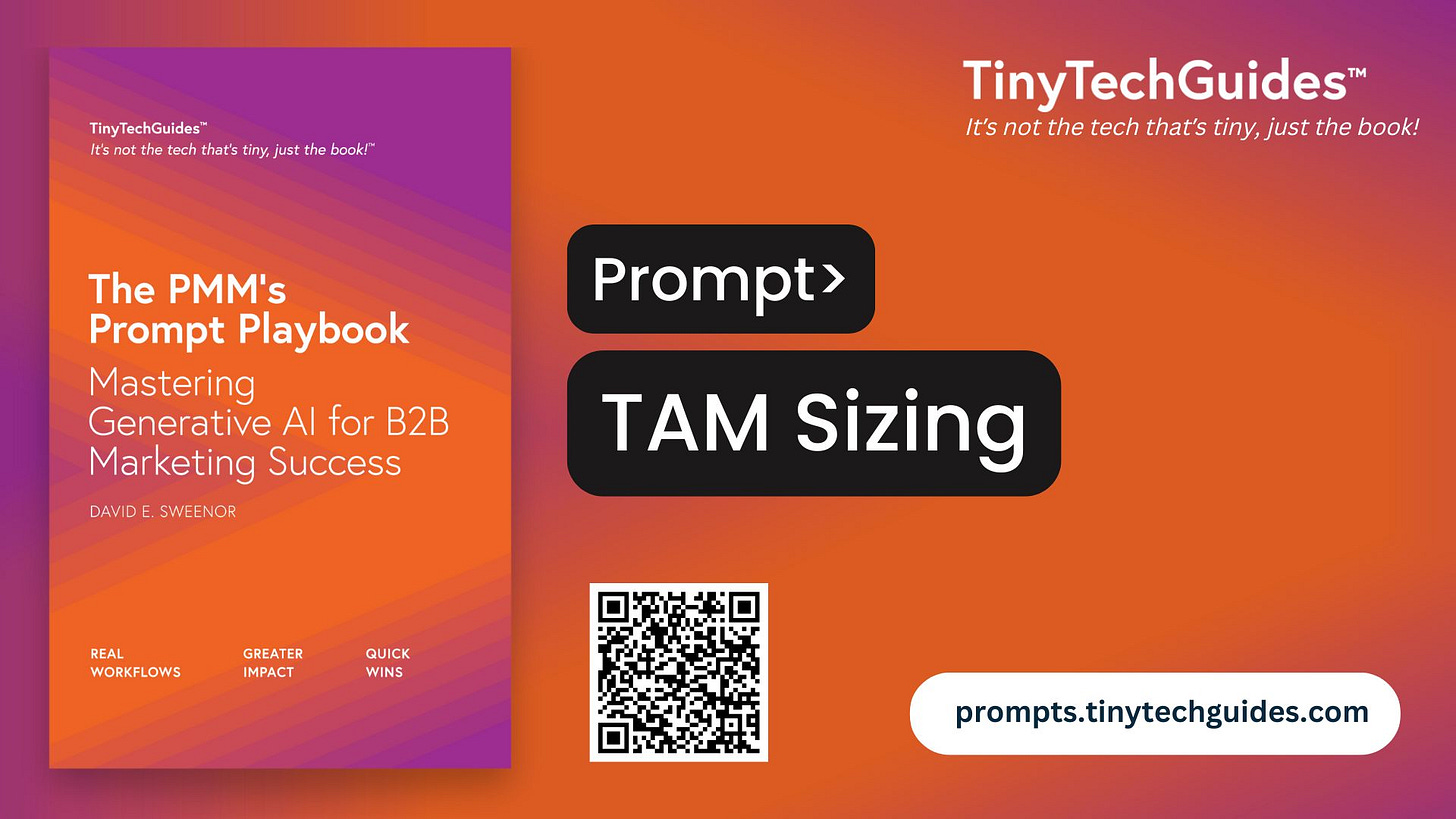Prompt Workflow: TAM Sizing
Market Understanding
TAM Sizing
This prompt, along with 30 others, is included in The PMM’s Prompt Playbook. These cut-and-paste prompts, along with bonus prompts not in the book, will be made available to paid subscribers on a weekly basis.
What does this do?
TAM Sizing is a systematic approach to calculating the total market opportunity for a solution within a specific industry. It evaluates the number of potential target organizations, their average annual spend, and projected market growth to provide a clear understanding of revenue potential. By integrating market segmentation, competitive benchmarks, and growth trends, TAM Sizing delivers strategic insights that help businesses prioritize markets, guide product investments, and optimize go-to-market strategies. This process ensures data-driven, scalable decision-making aligned with both current and future market conditions.
Workflow steps:
Define the TAM objective
Estimate the total number of target organizations
Define the average annual revenue opportunity per organization
Calculate the Total Addressable Market (TAM)
Provide assumptions and rationale for TAM calculation
Build context iteratively for accuracy
Validate with competitive context
Compare TAM estimates with competitors
Analyze key market drivers influencing TAM
Assess risks and opportunities affecting TAM estimates
Input (variables):
{industry=Insert your target industry, e.g., enterprise data analytics.}
{solution=Insert the type of solution, e.g., data observability tools.}
{audience=Insert target audience, e.g., enterprise companies or mid-market businesses.}
Define the TAM objective
# CONTEXT #
I need to calculate the Total Addressable Market (TAM) for {solution} within the {industry}. The target audience is {audience}, and the calculation should include both current demand and projected market growth over the next 5 years.
# TASK #
Provide a TAM calculation for {solution} in the {industry} using the following steps:
Step 1: Estimate the total number of target organizations in the {audience} segment, including a breakdown by size, geography, or vertical (if applicable).
Step 2: Define the average annual revenue opportunity (ARR) or spend per organization for solutions like {solution}.
Step 3: Calculate the TAM by multiplying the total number of target organizations by the average revenue opportunity per organization.
Step 4: Provide a concise explanation of the assumptions used (e.g., market penetration rates, pricing estimates, or adoption trends).
# FORMAT #
Provide the response as follows:
Step 1: Total number of target organizations.
Step 2: Average revenue opportunity per organization.
Step 3: TAM calculation (number of organizations x revenue opportunity).
Step 4: Assumptions and rationale used in the TAM calculation.
# TONE #
Professional, data-driven, and concise.
Build context iteratively for accuracy
# ROLE #
You are a strategy consultant with expertise in {industry} market sizing.
# CONTEXT #
I am validating TAM estimates for {solution} within the {industry}. I want to ensure the calculation accounts for realistic market conditions and is aligned with current trends.
# TASK #
Step 1: Target market definition. Estimate the total number of target organizations in the {audience} segment. Break it down by:
Organization size (e.g., SMBs, mid-market, enterprises).
Geographies or industry verticals (if applicable).
Step 2: Revenue opportunity. Provide an estimate of the average annual spend (ARR) for {solution} per organization, adjusted for company size or vertical.
Step 3: Market growth rate. Project the compound annual growth rate (CAGR) for {solution} within the {industry} over the next 5 years, citing key drivers like adoption trends, technological advancements, or increasing demand.
Step 4: Addressable market calculation. Multiply the target organization count (Step 1) by the average revenue per organization (Step 2) to calculate TAM. Adjust for projected growth based on the CAGR.
# FORMAT #
Provide the response in a structured format:
Step 1: Target organizations breakdown.
Step 2: Annual revenue per organization.
Step 3: Market growth rate (CAGR).
Step 4: Final TAM calculation and key assumptions.
# TONE #
Structured, analytical, and supported by evidence
Validate with competitive context
# ROLE #
You are an industry analyst comparing TAM opportunities for {solution} across competing vendors in {industry}.
# CONTEXT #
I need to validate the TAM estimate by benchmarking it against competitors’ market positions and industry growth trends.
# TASK #
Provide an analysis that includes:
Comparison of the TAM for {solution} against similar solutions in the {industry}.
Key market drivers or trends that may increase TAM over the next 3–5 years.
How competitors are addressing or projecting the same market opportunity.
# FORMAT #
Summarize the findings in bullet points, with comparisons across:
Competitors.
Key trends influencing TAM.
Risks or opportunities that could adjust TAM estimates.
# TONE #
Strategic, insightful, and comparative.
Why this workflow works
Ensures accuracy and scalability: Breaks down TAM into key components—organization count, revenue potential, and growth projections—allowing for a structured, data-driven calculation that can be adapted across industries.
Incorporates competitive validation: Benchmarks TAM estimates against competitors and industry trends to refine assumptions and provide a realistic market opportunity assessment.
Supports strategic decision-making: Helps businesses prioritize markets, allocate resources effectively, and align go-to-market strategies with long-term growth opportunities.



Thanks.. very helpful to see the prompts you construct